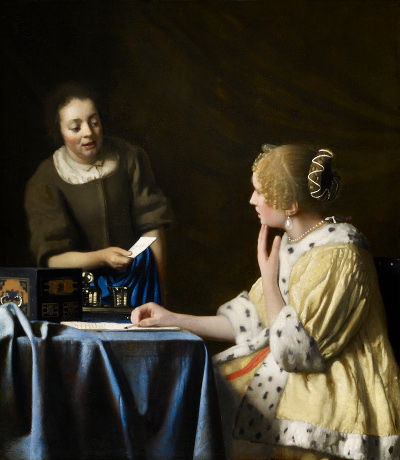Vermeer’s Jacket
Wouldn’t you love to crawl inside
that luscious gold? To wrap yourself inside
the satiny, charmeuse, rustling raiment,
decked out with an ermine muff,
embellished with tiny teeth and shiny claws.
Call that woman on the canvas
Vermeer’s excuse for a yellow immersion,
a tawny daydream edged in fur.
No matter how he arranges her—with the lute,
the maid, the guitar, the letter, the decent pearls—
she’s nothing but context
and costume, a recessive coolness
to set off what burns and glows—from brassy sheen
to coppery fire, a yellow to burnish winter’s pallor,
to ransom a drop of light—from metallic
to velvety—a concentration of sunlight
dragged back through leaded glass.
Or maybe he brought home
this sumptuous lure to heat up the muse
herself, waiting until the entire household slept
and then, when he burrowed his entire body
into all that silken topaz treasure,
he could paint anything he wanted.
From Dowser’s Apprentice, Glass Lyre Press, 2014.
Caravaggio’s on the Conversion of St. Paul
We don’t have to like his saint, splayed in the middle of the road,
don’t have to understand the illegible gestures made by his arms
flailing in air, this man who would, if he could, alter hearts by
telling the few they’re gold, as for the rest— we’ll burn. But our
painter—who has yet to leave a man dying from a street brawl in
Rome—he cherishes epiphany’s flash more than its prelude
or wake. In this painting notice how he’s placed the horse, a
sweet-faced, unkempt skewbald, who curls around the
fallen man, one foreleg raised so as not to injure. This
artist’s borrowed dray horse, led clattering to the upstairs
studio, swerves one ear to the background, other ear beyond
the picture frame. In his mouth
a shanked bit, likely the sort with sharp-pronged rollers, so
that when you tug the reins the bit will drag you five
centuries back before Saul became Paul, all the way to
Xenophon, instructing how to train your war horse with a
bit so severe, one touch and yes, he’ll obey, but won’t love
you. Hardly the point for a soon-to-be saint in whose
tumble out of matter toward purity, no easy conversation
between rider and ridden, no pleasure permitted.
From Moon over Zabriskie, Glass Lyre Press, 2014.

Art History
About beauty they sometimes get it wrong,
don’t they, the fine scholars,
bent on instruction? For example, right here
with Rembrandt’s Polish Rider, they carry on about
his sorry nag, meaning such a loser,
meaning, because our soldier doesn’t ride a
massive, buffed, and snorting charger (the
curators’ notion of warhorse, deriving from
pigeon-soiled statues, and the latest
remake of Henry V), they tell you where to read
failure—but so what if the horse is scrawny;
look at his rider armed to the teeth
with bows, knives, sword, and ax, scanning over his shoulder as he hurries, you hope to
safety, though the swallowing murk
of Rembrandt’s background refuses comfort
(the horse’s legs, states the placard, most likely
completed by the master’s apprentice). You can
see the soldier rides
the typical flea-bitten gray Polish Arabian.
This creature may be skinny, but he’s fit.
Ignore the critics and trust the horse to get
through winter, survive on snow melt and
whatever gruel the locals will spare.
If you wipe the smirk off your face and put
your feet in the stirrups, with luck the horse
can find the way.

Lives of the Clouds I
John Constable’s Cloud Study, 1822. The title
says it all, the roiling ones above, the white and
massy below, a few tinged rose, and a cloud
streaked gold rips open into blue.
But no one stops to pay homage, they’ve gone to see the
alleged Piero (read the small print: doubtful attribution,
school of ); and it’s John the Baptist with his head still on,
then everyone’s off to the Annunciation,
and Mary with her stricken schoolgirl look— Oh,
gosh, thank you, sir, but heavens, why me?
I prefer my Mary surly, as in, Hey, angel, can’t you tell I’m
busy. Over there, a famous flagellation
some enjoy comparing to others—more whipping,
less pathos—but let’s stay with these clouds, where
we can’t tell, dear viewer, if the view is out or up or
down—no figures, no horizon,
and what’s the weather, is it storming, or gusty,
maybe snowing. For an instant, we think it’s an
explosion—smoke, dust, and aftermath. And then we
see pure cloud pierced through by daylight, every
permutation illumined from within.

Upon Completing His Painting Entitled Madame X, John Singer Sargent Thinks about Talking with His Favorite Sister, Emily, a Fellow Painter, in His Paris Studio,
No other jewels, I told her, we will set off that pallor,
which as you know, she heightens with a good dusting of
lavender powder. The all of you, I didn’t tell her, trussed
up by ornament. But Emily, I’ve got it, haven’t I? The
strap of her dress lists off her right shoulder— twist of
pearl, gold foil—a trifling jeweled thing
nibbling the skin of her plump, undamaged arm. Not reckless
what I’ve done? She’s eccentric in style, an arriviste,
parvenue. With no real daring, not like Mother— oooh,
children, off we go, to Florence—but do you like the dress,
black, verging on aubergine? Her beauty, what can I say—I
stare. And flinch. Is of a dusky plum,
won’t dry into a prune’s sweet leather, but will spoil at once,
without a trace. Nothing worked. I tried her on chaise, on sofa,
twisting her arms. Here, I have her leaning on the table, her
arm torqued; its weight spirals down.
I tried the pose myself. It felt spectacularly tentative. But some
days—damn them, these ladies, and damn this one’s
right ear, this flaw, I painted a too-pink little object coiled against
the head, but some of Mother in the bosom’s plunge to seemingly
nowhere. Lord, I pity a beautiful woman’s son. Happiness to
these people? They find it cheap, requiring a surrender that’s been
bred out of them. I long for sunshine, a tramp along the sea with
you. Remember that gypsy woman—
poor and drunk and slovenly and glorious—I painted last year in
Venice? Wonder if she’s alive. She was so full of her life that it
poured off her. You could scoop the vitality with your brush, paint
with menace and grace. But Madame X—her beauty is milky, marbled—
no, chalky—like the Dolomites. She exudes chilled air, as breathed off of
new snow. Her sorrow lives in this gray pool smudged
beneath her eyes to which viewers will return for repeated sips. I
doubt that she is loved. Someday, enough of the gorgeousness I’m
hired to serve, much as the governess or their butler. I do their
dogs, their brilliant children, make them all goddessy. When are
you coming? I want you to see the glow–of gentian past bloom—
I’ve laid along her throat. Will you like it?

The last three poems are from In Search of Landscape, Sixteen Rivers Press, 2007.

Helen Wickes is the author of four books of poetry: In Search of Landscape, Sixteen Rivers Press, 2007; Moon over Zabriskie and Dowser’s Apprentice, both from Glass Lyre Press, 2014; World as You Left It, Sixteen Rivers Press, 2015. All six poems published in this article are from an unpublished manuscript titled “Transit of Mercury”. She grew up on a farm in Pennsylvania, has lived in Oakland, California for many years, and used to work as a psychotherapist. She is a member of Sixteen Rivers Press, which has recently released the anthology America, I Call Your Name: Poems of Resistance and Resilience.





















































